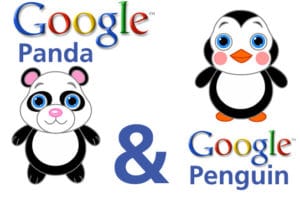
Google Panda Updates, since its introduction, made the SEO community roar about websites losing search engine ranking. We too have posted several dedicated articles about Panda updates. Though many raised concerns about these updates, I think Panda updates will continue to improve the quality of SERP, removing the medium to low quality sites from the top ranking positions.
What is Google Panda Update?
The stated purpose of the Google Panda algorithm update was to reward high-quality websites and diminish the presence of low-quality websites in Google’s organic search engine results.
By Moz.com
What is Google Penguin Update?
Google launched the Penguin Update in April 2012 to better catch sites deemed to be spamming its search results, in particular those doing so by buying links or obtaining them through link networks designed primarily to boost Google rankings
By Search Engine Land
Difference between Google’s Panda and Penguin
Know the difference between Google Panda updates and Penguin updates so that you can take preventive measures for your websites to rank well.

Google’s Penguin updates seem to have brought about a tsunami in the online world. There are widespread speculations about Google’s new Panda and Penguin algorithm. Many webmasters feel they have been unduly penalised.
Penguin update has been in news and great minds are pondering the effects of this algorithmic change. Just a few months back the webmasters thought they had finally solved the riddle of Panda update. Seldom did they know Google would come up with a new challenge for them.
According to many, if Google’s Panda update was dangerous for online businesses than Penguin update is uglier and more dangerous. Penguin seems to be more penalizing then Panda. So let us compare these two algorithms and find out what they actually represent.
How to cope up with Google Algorithm updates
Google Panda Update
Panda update is a good old algorithm which has been around for quite some time now. Google Panda update looked to penalise sites or blogs that had poor quality content in them. This algorithm works in a complex manner calculating the relevancy and quality of your content.
From its onset Google has been in favour of adding value to online time of users. What users want from Google is good result pages that provide them with quality information and solve their problems. Panda update was looked by the experts as a way for Google to create world’s largest authentic information library.
Google denounced many sites and blogs having poor content. They felt these could be sacrificed for the larger good of online users. But the blog and site owners represented a different story. Panda update was done on April 19, 2012. By this time webmasters and SEO experts had found out ways to counter their situation.
One of the best remedies to overcome ill effects of the Panda update was to fill your site with good content. You might have been victimized if you participated in link exchange or link networks. Getting links from reputed sites was hailed by Google but sites with links from link farms were denounced. Webmasters purged their sites by removing links from doubtful pages.
Google Penguin Update
It is the latest algorithmic change for judging blogs and sites. The prime purpose of Penguin update was to remove all spammy sites. These sites were removed from the search results. Some webmasters might be smiling as they feel their site does not have any spam, you should double check. Many excellent sites have been hit hard by the Penguin update. Over optimisation of sites is a crime according to Penguin update.
The worst scenario: Google will not reconsider indexing these sites even if you prove that your site is genuine. To counter negative effects of Penguin updates you should regularly monitor your link profiles. Only relevant links from niche based sites should be kept.
Your content and links should appear natural otherwise you may incur the wrath of Google.In a bid to stamp their authority and prove they offer the best search, Google is out to eliminate all poor content from their search results. You have to play by the rules and use only White Hat SEO tactics to prosper.
Google Panda 4.1: Some Lessons Learnt

The Panda updates of Google are always looming around the corner, checking up websites that are flouting the rules. Webmasters and internet marketers are perennially wondering about how their websites fare on Panda’s score sheets. The sheer range of aspects that Panda takes into account makes it practically impossible to duck under its radar.
The other weapon of Google, Penguin, shows up now and then, penalizing websites, setting the scores straight and leaving some websites in tatters. Panda updates, on the other hand, are there for keeps. It makes is doubly important for websites and SEO professionals to understand Panda and incorporate the lessons and guidelines in their work.
In this post, we are looking at some of the lessons that Panda 4.1 update has to impart for us, the SEO professionals, and digital marketers. These lessons are necessary to ensure that you are always on the good books of Panda. Check them out:
The Do’s
- There is no chronological order as such but the lesson at the top of my list is the need for every single web page to serve its purpose. For example, a services page must give out information about products and services in a way that users benefit from the content of the page. There are too enemies of this line of web page construction: trying to pack in too much material in one web page and being confused about the objective of the page. Talk it out within your team as to what you want the page to accomplish. In another example, if you have a signup page, put the signup box and important instructions above the fold. This gives clear indications to Google that you are giving value content and pulls down the bounce rate of a web page.
- Offsite references carry a lot of weight in the context of Panda yardsticks. Google identifies and knows the experts in every single domain of business. The movers and the shakers of your business field are right there in Google’s books. The question is: are these people talking about you or your brand? If the answer is yes, you are so on the right track! If no, you need to make that happen. You need that buzz where industry experts use your web content in their articles and blogs, social media mention, the works. When that happens, you get quality traffic to your website and deflect the attention of Google towards your website. If you continue with the good work, you will be designated as a industry expert yourself, a status that will do wonders for your brand. Getting inbound links to your website and positive reviews are par for the course.
- A quick look through the Quality Raters Guidelines is all you need to understand this line of thinking from the Panda. You cannot allow the user experience of your website to be interrupted by the ads that you put up. There is little more frustrating that popup ads showing up every now and then, breaking through the smooth user experience. There is no denying the fact that ads bring revenue but to you and to Google, websites are for users, not ads! Ads are there because users are there. You cannot afford to drive away users because of your interfering ad scheduling. Quality Raters Guidelines tag this ad interference as a gross violation that goes completely against the fabric of the internet experience.
- Imagine a situation where you write an exam for 180 minutes and submit the paper only to realize that you have forgotten to write your name on the top! That is what happens when after all the pains you take to prop up your website, there is a naked Apache link somewhere, a broken navigation there, spelling mistakes littered around, etc. These are counter-productive and contrary to belief, NOT minor glitches! On the computer screen and in this phase of the information age, these are amplified multiple times. Proof-read your website and tie up the loose ends. When Panda comes visiting, you don’t want to be caught napping
There are some don’ts as well that can take a look at:
- A much known but much abused tip: don’t repeat keywords. Not in a single web page, yes, and not sprinkled over the entire website either! Keep it very natural (where have you heard that before!)
- Don’t publish content because you are ‘doing SEO’. There cannot be a worse reason for writing blogs or articles. Focus on the purpose of developing user experience through your content. The SEO part will follow suit
- Don’t miss out on providing validated business information on every web page of your website. You never know when the user decides to contact us. Don’t allow the user to hunt around for contact coordinates
- Don’t forget to quote references. Attribute your post to the parent material so that Google knows that you are playing by the book and want to give credit where it is due.
Have some questions about Panda 4.1? Ask me here!
How to beat Google Panda & Google Penguin Updates
Google Panda updates have forced us to think out-of-the-box. You need to be strategic not only with your content, but also with the other factors to give your visitors a better user experience. To begin with, you may start adjusting your website in order to suit the behavior of your visitors. Give them more industry related content in order to increase their on-site time. This will eventually help you to increase the pages per visit, while reducing the bounce rate.
Reduce the bounce rate
Google Analytics will give you a detailed picture of your bounce rates. Mark the pages that have high bounce rates and start working on them. Study the pages and determine what made your visitors leave your site. Is it poor quality or irrelevant content? Are the ads you have on page annoying the people?
Or is it that your visitors don’t know what to do after they reach a particular page and you have failed to guide them? If it is the quality of the content, edit them. In case of irrelevant content, remove them altogether. Also avoid giving too much of pop-up ads. Make sure the ads are not disturbing the visitors while reading the content.
Most of the times, it was noticed that the blog sections have the highest bounce rate. This can be due to two reasons – first, the quality of the content, which we have already mentioned. Second, visitors are often clueless about what to do after find the information they were looking for and leave the blog. The second issue can be managed with some strategic steps.
You need to guide your visitors to the next content that they might find interesting – use a suggestion fly-box. Once your visitor scrolled down the end of a post, suggest another random post from your blog section. This is one of the best ways to lower the bounce rate of your blog section.
Increase the number & length of quality content
The amount of content on page is an essential factor for Google Panda updates. The search engine is skeptic about pages with thin content. Thus, increase the volume of content of each page. This is especially applicable for e-commerce sites as the product pages of these sites are the easy victim of thin content. One solution is to write a detailed description for each product.
The sites using user-generated content like reviews should have a minimum text required to be posted. Another tip is to use a spell checker on the review form to avoid as much spelling checking as possible.
No duplicate content
When we said add more content to each page, we meant fresh and unique content. Having same content on several pages is a big no-no for Panda updates. Having duplicate content on your website is one of the biggest risks that can damage your search engine reputation. Also, your site is more likely to end up in the supplementary index.
You entire website can get penalized by Google and the search engine giant will not display your site until the ban is removed. Though it is possible to lift the ban, it won’t be overnight. And by the time Google will lift the ban, you would have lost your reputation and a lot of your visitors. Thus, removing all your duplicate content should one of your priorities.
Related reading: How to optimize your content
Content is King!

We have often heard of this saying: content is king. However, when it came to operations online, even a couple of years back, you had websites with web content packed with keywords grabbing the top slots on SERP results. This was almost unfair to all those websites that had genuinely good content but was not being able to hike up their ranks. This kind of unfair level field was proving to be disastrous for online SEO. More companies were interested in content farming with high keyword densities rather than relying on excellent content.
Then came Google’s Panda and ground realities changed. The dichotomy between SEO results and what web content pundits preached got blurred and finally erased. There was no conflict of interest in the quality of content and the SERP verdict.
With the Panda algorithm, Google finally crowned content as the undisputed king! With quality content, you now have to power to beat other websites with perhaps better link building network and other SEO advantages. On-page content is now the final decider on which website makes it to the top of the SERP heap and which ones fall by the wayside.
Long-tail keywords and their use in content is another winner. The advantage of using long-tail keywords is that it enriches the content as well, along with the keyword quotient. Long-tail keywords can be used more naturally and to borrow an often-used word of SEO experts, organically.
From an SEO point of view, long-tail keywords have less competition and therefore, your content has better chances of being indexed in these relatively easier SEO battlefields. What it also means is that this is another victory of content over pitched battles between high-ranking keywords parsed from Google Adwords by overzealous online companies.
With long-tail keywords focusing on brand names, it has been noted that a website of the brand’s franchise owner ranked higher than the official website of the brand itself! Moreover, the CTR (click through rate for the uninitiated) was also higher on the franchise website.
A casual analysis revealed a barely covered truth: the franchise website had a far superior website in terms of content! Lesson learnt: no matter what your ranking is on the SERP scale now, brush up and fix your content end and you will soon head to the better side of the SEO pool.
Focus on social media relation
Your social media relation can help you to minimize the adverse effect of Panda updates. Google counts and values the social mentions. Make sure your website has social presence on the three major social networking sites – Facebook, Twitter, and LinkedIn. And don’t forget the search giant’s social channel Google+ when it comes to improve your social presence.
In addition, focus on the other social channels, especially the bookmarking sites like Digg, Delicious, and StumbleUpon. The content liked and shared by people on these social networking sites help you to gain higher value on Google. For the search engine giant, it is considered as an approval when someone mentions your site on social media.
Optimize your site for mobile browsing
The bounce rate of your site may increase if it is not mobile friendly. Make sure the loading time is minimal for the mobile users and the images are opening properly. Also, focus on the front size of your content. In short, create a full-featured mobile website. In case you have a flash site, change the template for the mobile version to improve the loading speed. Apart from decreasing your bounce rate, having a mobile friendly site will help you in achieving higher conversion rates.
In summing up, make sure your website has lower bounce rate, and add unique content that can add value to your visitors’ experience. Use high quality and informative content, instead of focusing on the quantity of content. Be strategic, if using user-generated content.
Also, make sure your web pages have incoming links from quality sites. Google values back links from authoritative sites. Add social media buttons on your site to help users to share your content on the major social channels. Finally, limit the number of ads on your web page. Websites with too many ads pose the risk of being penalized by Google.
Related reading: How to diversify your SEO strategies to reduce dependency on Google
Link Building Dont’s and Do’s After Penguin Update
- Lack of Social Signals– Google is paying more attention to social signals when determining search engine results page rankings. In order to take some of the power away from those that purchase links from unrelated sites, link farms and blogging networks that practice spamming, Social sharing from Google+, Facebook, Twitter, Digg and Reddit are now influencing the rankings a site receives from Google.
- Create Google+ and Facebook pages as well as a Twitter feed.
- Provide up to date, informative content to all social media sites.
- Be sure to add badges to your website allowing visitors to become friends, connections and followers.
- Include social sharing options to your site, enabling visitors to share content they themselves deem informative.
- Too many exact match anchor text links – In the past standard link building profile was to achieve 70-80% of the inbound links as exact match anchor text links. Now it is recommended that only 10% – 40% of the inbound links profile is exact match.
- Brand Anchors – This form of link anchor text incorporates the name of your business into the keyword text and are commonly used to link back to the home page. In order to make it appear more natural, consider linking brand anchors to the internal pages as well. Keep 10-15% of inbound links as brand anchors.
- Junk Anchor Text – Often seen as “contact us” and “visit us today”, this form of link text is important to use as it looks most natural to Google. Keep 5-7% of inbound links like this.
- Latent Semantic Indexing (LSI) – Simply stated, this type of text link is composed of words that are related to the targeted keyword. For example, a site that features “marketing” would target word phrases such as “marketing strategies” or “free marketing tips”. This type of keyword is important as it is more natural for searchers to search for keywords of this nature. Keep 15-20% of inbound links like this.
- Naked URL’s – In short, Naked URL’s are just variations of your sites web address. For example; www.7boats.com can also be labeled as http://www.7boats.com or http://7boats.com. These URL’s can be linked to both home and internal pages of a website.
Related reading: How to build links & how to analyze your backlinks
Next Steps
For those that have been penalized or deindexed by the latest Google algorithmic change here are a few steps you can take to recover.
- Remove or change incoming links that use exact match anchor text to Brand, Junk, LSI or Naked URL’s.
- Abandon your current link building campaign and start fresh with a new campaign that consists of a well rounded strategy that incorporates all anchor text techniques.
- Get Social on Google+, Facebook and Twitter. Include Reddit and Digg social sharing options, as well as others, to all website pages.
Google is constantly changing the way it determines search engine results placement. Keeping up with the changes is an ongoing endeavor that can take up an enormous amount of time.
Read about how to stay safe from Google Penguin update
SEO Techniques Following the Penguin and Google Panda Updates

The Google Panda and Penguin updates caused problems for many webmasters. If your site has been penalised by the updates, read on to discover a few tips to help you recover. Those who are not aware about these Panda or Penguin updates, read about What’s the difference between Google Panda & Google Penguin Updates?
Google’s Penguin and Panda updates were supposed to target low-quality sites that had a lot of duplicated content or suspicious link profiles, ensuring that those sites were not dragging down the quality of search results. Sadly, many legitimate sites also got hit, either because they had a lot of site-wide links from their (legitimate) link partners or because their e-commerce sites appeared to have a lot of duplicate content thanks to product descriptions and category listings appearing on multiple pages.
The good news is that it is possible for a site to recover from a Google penalty. In fact, many sites that were hit during the initial Google ‘dance’ recovered as soon as Google updated its ranking systems. If your site is still suffering today, you may need to enlist the help of a company that provides SEO services. To prevent yourself from being hit by more penalties, you might want to pay attention to the basic SEO rules described below.
Content is King
Any good SEO services company will tell you that good content is essential for good rankings today. Changing a few keywords here and there will not be enough to help you climb in the rankings and ‘spinning’ your content is a definite no-no. Google wants unique content that has been written by real people for interested readers. These days Google is hard to fool, so do not even try. Write good content. It will pay off. Some of that content can be link bait, but plenty of it should be evergreen, informative articles too.
Say No to Old Tricks
Keyword stuffing, paid links and hidden text and links designed only to be seen by search engines are best avoided. These SEO techniques were either black hat or certainly grey hat back when they worked and now that Google is looking out for them they are most definitely dangerous to your search rankings. Today, the best way to get high-quality links is to create content that is worth linking to and to use guest blogging and social media to spread the word about your website.
Put the User First
Your site should be designed from the ground up to be user-friendly. This means easy navigation, quick loading times and engaging content above the fold. Having an easy-to-use website will keep your bounce rate low and make Google see your website in a more positive light. It also helps to have a strong social media presence. Talk to your users and build up a community around your site.
SEO consultants can help you improve the coding of your page, tweak your layout and build up a good link profile, but you will need to make your website worth visiting. Invest time in creating good content and be sure to refresh it regularly. If your content is worth reading, visitors will follow.
Best 5 Tips to Combat Google’s Panda
Without the patronage of Google, you won’t be able to survive on internet. Here are the best 5 ways in which you can pull up your socks against Google’s Panda.

Worried about the dreaded Google’s Panda updates derailing your online marketing initiative? You actually have enough reasons to worry about if you are resorting to underhand means in order to boost things up for your website. The penalty of offending the Panda can be more severe than you actually realize. Without the patronage of Google, you will not be able to survive on the internet marketing scene. Here are the best 5 ways in which you can pull up your socks against Panda:
- Avoid Thin Content: By thin content we mean web pages with less than 100-200 words of content. You have to work on the content of these web pages and add to it. Make sure that your content is relevant and complements what is already on the page, namely, an image or infographics.
- Too Many Ads: Panda understands your need to monetize your web pages. But you cannot do that at the cost of your website users’ experience. Too many ads create a clutter on the page, making it difficult for the users to get through to the actual content.
- No Duplicity: If there is something that brings out the tooth and nail in the Panda, it is duplicate content. No matter how difficult it may be to get raw materials for your content, by all means avoid the temptation to lift. Make use of a good plagiarism checker to guard against unconscious duplicity of content.
- Improve Quality: Do not compromise on the quality of your content if you want to satisfy the tenets of the Panda. Get rid of hacks doubling up as your content writers. Invest in a good ghost writer and get the best quality of writing for your web pages. It will work well with Panda and of course, your online readers.
- Be Unique: There are no slots for wannabes and me-too enthusiasts in the reign of Panda. You have to tread a different path for your online success. No walking through the safety of the beaten track. If your content is unique and original in appeal, you are ahead of the curve by default. You will also have conquered Panda updates.
How you can Stay Away from SEO Sins and impress Google Panda

So, it’s the Panda again, no we are not talking about getting caught by the new crawler; we are here to talk about how you can stay away from SEO sins. February 2011 saw a big change in the algorithms. The standards have changed with the arrival of the Panda. It is has been found out that the role of organic traffic has increased by a whopping 49%. Yes you have heard it right!
Surprisingly Panda has showed inorganic SEO practices the way to the bin. Poor contents, links and sites are thrown away. This has led Birmingham SEO professionals to take the right step. Now is the time when we find superior contents and excellent blog posts rolling across the web.
Original contents are what we find floating on the internet. Ill-formatted sites and contents are a big no-no on the web; though there are still some who believe in unauthorized practices.
Panda ascertains quality of content or a site from the perspective of a human. Being a professional in Birmingham SEO you must see to it that your page abides by the algorithm set by the Panda. The fall will be observed soon after the crawlers find that your page is not up to the mark.
The sins you should avoid
Duplicate code: You must see to it that the codes you have designed for your page should not match with a similar on the web. Instantly you will be denounced as duplicate. It has been found that if 95% of the codes tend to match with another site then Panda is there to hit you.
Empty Pages should be eliminated at once. Experts have found that some pages exist to link you to another page. They are completely empty and don’t land you anywhere on the web. All you need to do is add relevant and quality pages over the internet to avoid Panda penalties.
Adsense optimization: It is not necessary that you optimize your adsense over the internet. Chunks of ad floating across a web are considered spam by Google updates. Sticking relevant and consistent messages to your page ends your frustration.
Fixing such problems seems way too hard than avoiding the issue. So, it is time you eliminate such mistakes from beforehand. The Panda is making way for quality traffic so that you earn leads. The technology is widely in use and the entire web is accepting it as a major way to rule.
It is better if you refrain yourself from the possible sins mentioned above and accept the upgraded algorithms instead. You will find striking results in return with increased page view, reduced bounce rate and superior traffic to your page.
Will Google Penalize Sites with Excessive Above-the-Fold Ads?
Anything “above the fold” attracts attention. The bad news is it may even attract unwanted attention from authorities. Google, for example, is likely to penalize websites with excessive above-the-fold ads.
Websites, which are supported by advertising usually, put most of these ads near top of the page. This is attracting some unwanted attention from Google. And at present Google’s main focus is to provide its users with sites that have best answers to their respective queries.
For this search giant, the user’s experience is the most important factor. Based on this, the search engine has also changed its algorithm with Panda updates. As a result, sites with thin content and content farms that cluttered search results with poor quality pages are devastated.
The content freshness updates of Google are motivated by searcher concerns. If you think like a searcher, you too would like to have meaty content to answer your queries and not pages filled with irrelevant ads. It is likely to be a frustrating experience if only an inch or two of the real content is visible or if you have to scroll down to read the rest, thanks to the annoying above-the-fold ads.
You love it or hate it; Internet has shortened our attention spans and has also made us a little lazy. We hate to scroll down through advertisements only to find the page hardly have some quality content to answer our queries. So you really can’t blame Google for choosing to do something about it. In their blog post the search giant mentioned they changed their algorithm to look “at the layout of the webpage and the amount of content you see on the page once you click on the result.”
They have taken the users complaints seriously in terms of excessive advertisements – “Rather than scrolling down the page past a slew of ads, users want to see the content right away. So sites that don’t have much content ‘above-the-fold’ can be affected by this change…Such sites may not rank as high going forward.”
As expected, Google will be singling out sites with excessive above-the-fold ads. However, sites with normal amount of advertising that help to monetize their content have nothing to worry about. According to the search engine the Panda updates “noticeably affects less than 1% of searches globally.” For sites that are affected, there is Google’s Browser Size tool that helps to check the site’s appearance under different screen resolutions.
Google’s is likely to penalize you, even if AdSense ads are the source of your excessive above-the-fold ads. The search giant has already mentioned that pages filled with AdSense ads are as subject to their algorithm change as any other pages on the web. Thus, make sure your pages are not cluttered with such ads if you want to maintain “good standing in Google’s search results.”
The question now arises is how to ensure that your site is not affected by this algorithm change? It’s pretty simple to make out, providing you are not living in a fool’s paradise and are ready to face the reality. Any site that has little or no content above the fold for screen resolutions generally used are already affected by Panda updates. Have you lately seen a drop in your web traffic? If yes, you have been hit be the Panda and you first need to get rid of those excessive above the fold ads to get that traffic back. But, be assured it won’t happen so quickly.
Google has decreased the entire site’s ranking and not just one of the pages, thanks to your ad-heavy above the fold. Even if you have already removed them after noticing the fall in the traffic, don’t expect any immediate result. The search giant is less likely to change their impression about you until their next visit, which may take several weeks.
What to do?
Yes, you are stung. Accept that! No, there is no way to get around apart from waiting Google’s next “update”, no matter how much you hate it.
The time Google takes for its next update depends on various factors, including the size of your site. In the mean-time start reading Google’s blog that says: “our advice for publishers continues to be to focus on delivering the best possible user experience on your websites and not to focus on specific algorithm tweaks.” So start considering your user’s experience on the site if you are yet to do it.
However, sites with a small ad or two need not worry as long as the advertisements are not getting in the visitor’s way to view the content clearly. Google’s algorithm change is designed to find sites with excessively ad-heavy above the fold and will hardly affect your site if user experience is your prime focus. Also consider that, having just an ad above-the-fold will not affect your site, as it is common for Google to have no ads or just a few ads on a web page.
Our advice
Take a long and hard look at your site and measure it up as a searcher. And if you too find those ads covering the content annoying, it’s time to change the layout of your page as well as Google’s opinion about you. Check your layout what’s there above-the-fold .
What are the best ways to stay safe from Google’s algorithm updates?

Google changes its search algorithm more than the average person changes their undergarments. Just kidding – or am I? All joking aside, the company is updating its ranking technology on a frequent basis, and more often than not, these updates come with major implications. SEO managers are responsible for keeping up with the changes, so here is an article explaining the best ways to stay on top of all the algorithm tweaks.
Follow Google
Lately, Google has been more open than ever about its algorithm plans. For instance, the company gave us all a heads up before rolling out Penguin, a recent update that specifically addresses web spam. This is unlike in the past, when it would make changes without the giving the slightest warning. No one knows why, but that doesn’t matter. What’s important is knowing that you are now more likely to have time to prepare and preserve your rankings. SEO managers would be wise to follow Google through the blogosphere, social web, and other online destinations to get an idea of when changes might be coming.
Be Aware
While Google has recently taken a friendlier approach to algorithm updates, it would be unwise to get comfortable and count on things remaining this way. Today’s tweak could be something we knew about well in advance, while tomorrow’s might come announced and threaten to catch us off guard. Google is not obliged to share any information, and this is why it pays to stay aware of your status. Has your number of average daily visitors suddenly decreased? Has your site dropped from first to fifth in the rankings? SEO managers who keep a watchful over their data and positioning can react to algorithm changes before too much damage is done.
Adopt the Best Practices
Over the years we have learned that no matter how many tweaks Google makes to its algorithm, those who do SEO right suffer little to no consequences. By adopting the following best practices, SEO managers can make sure their prominent search presence remains intact:
– Create content that offers value to human readers – not just search engines
– Link to relevant sites with high ranking authority
– Create original content and avoid duplicate material
– Keep advertising content to a minimum
– Publish content that is rich in relevant keywords
– Don’t over-optimize (e.g. using too many keywords, having too many links to low-quality sites, etc.)
Staying on top of Google’s ever changing algorithm is a never-ending mission for SEO managers. And while keeping up with all the tweaks is no doubt important, it is also nothing to get too stressed out over. Even Matt Cutts, one of the leaders of Google’s search team, warns that we shouldn’t chase the algorithm, but focus on delivering what our users want. This is perhaps the best advice to follow because when users are happy, everyone is happy, including Google.








Good Article…
I have shared with my Webmaster Team too..
Thank you Subu
Hey Deb, I have landed in your blog while touring in the blog land. I was quite impressed with your write up. The points you have shared with the readers – truly amazing and well written. This is true that Penguin has become a threat to all the SEO people and the webmaster. But I can suggest all the readers that Keep concentrate on quality then Quantity while creating the links for your site. Thanks so much for this lovely aricles – will make sure to visit back again. :)
Thank you Kendell for your comment.
I was confused b/w panda and penguin update. You clarify my concept. Thanks for sharing.
Thank you Pulkit.
Howdy, I’m new to running a blog and internet sites in general and was wanting to know how you got the “www” included in your web address name? I see your domain name, “http://www.7boats.com/what-are-the-best-ways-for-seo-managers-to-stay-on-top-of-googles-algorithm-tweaks/” has the www and my web address looks like, “http://mydomain.com”. Do you know the easiest way I can alter this? I’m using WordPress platform. Thank you so much
Hi Eel Sushi, Thank you for your comment. this is called 301 www & non www resolve. Either way you can redirect your domain name to resolve only at www or at http. You can change it from your cPanel. Login there, go to “Redirects” and change to “resolve http:// to http://www“
My site was punished by Google, but there is a strong difficulty in bypassing the punishment
Sorry to hear that Dhia. It takes time. You have to follow all the white-hat SEO and page experience techniques along with strictly adhering to the Google’s webmaster guideline and content guideline. You have to keep patience and once you make sure everything you have followed well, you can submit a reconsider request to Google.
It is very helpful and interesting . Thank you for sharing a great information .
Read more about SEO visit v8web.com
That was an amazing article about Google Panda, it helps me in understanding how Google Panda is important.